ASUS P8Z77-V Deluxe Review - Know Your SKU
by Ian Cutress on May 12, 2012 8:45 AM EST- Posted in
- Motherboards
- Asus
- Z77
LAN Speed Test
LAN Speed Test is a freeware program designed for testing the network connection between two PCs on a home network. The speed of the transfer is limited by the lowest common denominator on the network, so if you have gigabit Ethernet capable computers but a 100 Mbit capable router, you are limited to 100 Mbit transfer. Note that this is really a formality – if a network port is rated at 1 Gbps, then chances are that it should hit at least 90+% of this value. The main test here is CPU usage, and how much is offloaded by the controller. For this test, we use LAN Speed Test to transfer 1000 x 1 MB files across a home network with a 1 Gbps lowest common speed to the same machine each time, in a read/write scenario.

Due to a new slight variation in our LAN testing, the LAN Read numbers for our Z77 lineup are void - as soon as we can get time to test the previous boards, we will include the numbers back again. In terms of sequential write testing however, the Deluxe does well on the Realtek NIC.
USB Speed
For this benchmark, we run CrystalDiskMark to determine the ideal sequential read and write speeds for the USB port using our 240 GB OCZ Vertex3 SSD with a SATA 6 Gbps to USB 3.0 converter. Then we transfer a set size of files from the SSD to the USB drive using DiskBench, which monitors the time taken to transfer. The files transferred are a 1.52 GB set of 2867 files across 320 folders – 95% of these files are small typical website files, and the rest (90% of the size) are the videos used in the Sorenson Squeeze test.
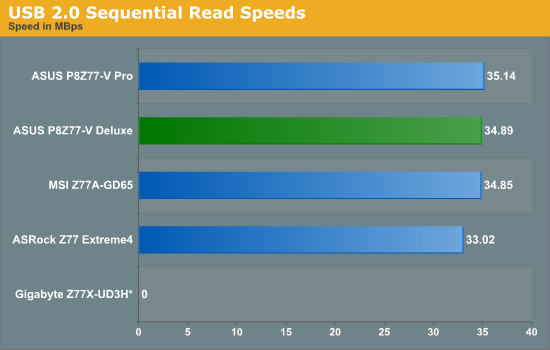
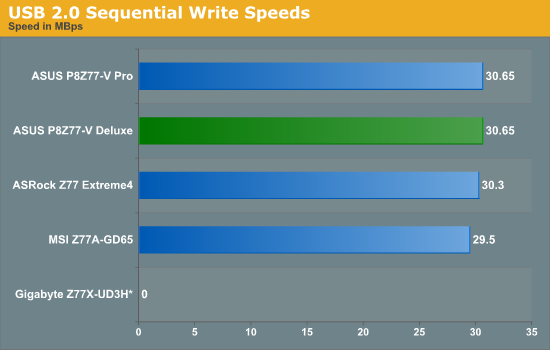
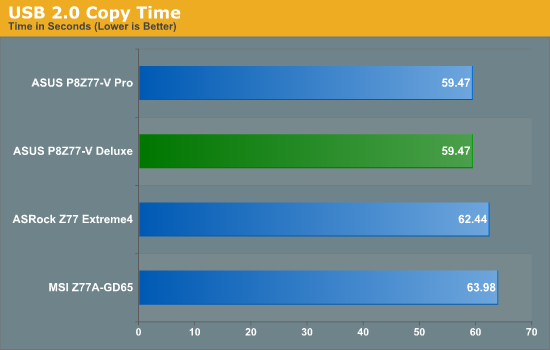
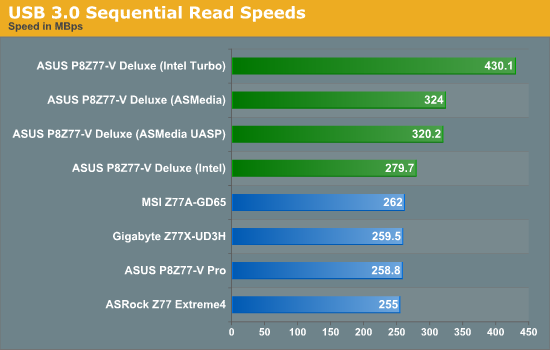

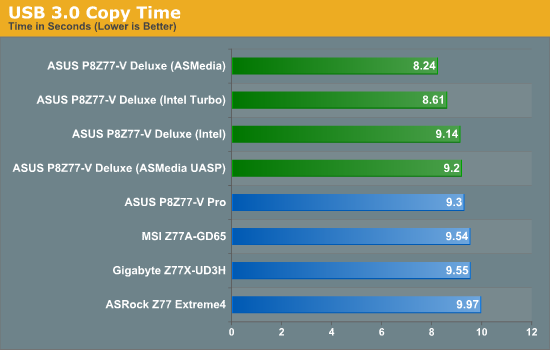
USB results, in particular the USB 3.0 results, are rather impressive - both the ASMedia and Intel controllers out perform the Intel controllers on other boards in our absolute copy test, and even more so when under USB 3.0 Boost modes.
SATA Testing
We also use CrystalDiskMark for SATA port testing on a C300 drive. The sequential test (incompressible data) is run at the 5 x 1000 MB level. This test probes the efficiency of the data delivery system between the chipset and the drive, or in the case of additional SATA ports provided by a third party controller, the efficiency between the controller, the chipset and the drive.
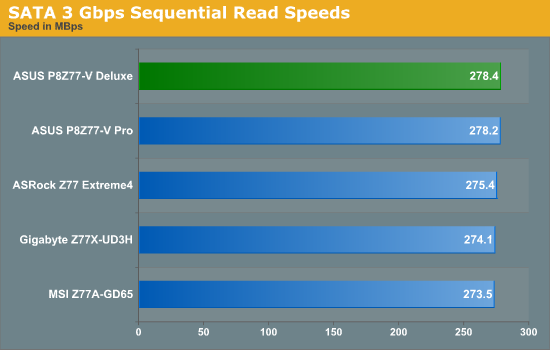

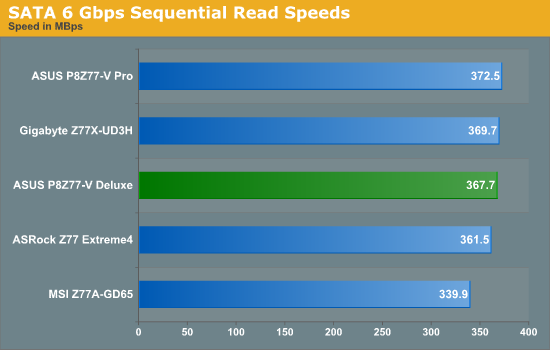
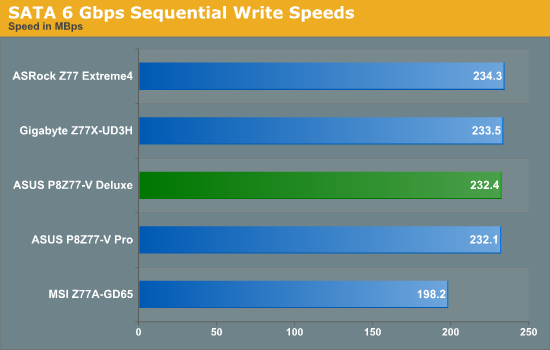
SATA testing on the Deluxe shows no abnormalities.
DPC Latency
Deferred Procedure Call latency is a way in which Windows handles interrupt servicing. In order to wait for a processor to acknowledge the request, the system will queue all interrupt requests by priority. Critical interrupts will be handled as soon as possible, whereas lesser priority requests, such as audio, will be further down the line. So if the audio device requires data, it will have to wait until the request is processed before the buffer is filled. If the device drivers of higher priority components in a system are poorly implemented, this can cause delays in request scheduling and process time, resulting in an empty audio buffer – this leads to characteristic audible pauses, pops and clicks. Having a bigger buffer and correctly implemented system drivers obviously helps in this regard. The DPC latency checker measures how much time is processing DPCs from driver invocation – the lower the value will result in better audio transfer at smaller buffer sizes. Results are measured in microseconds and taken as the peak latency while cycling through a series of short HD videos - under 500 microseconds usually gets the green light, but the lower the better.
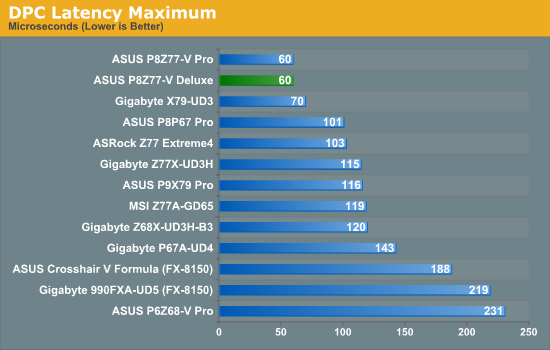
The agressive BIOS settings of the P8Z77-V Pro and Deluxe have helped both of them get the best ever results in our DPC Latency test.










52 Comments
View All Comments
lbeyak - Saturday, May 12, 2012 - link
"The ECS Z77H2-AX and Gigabyte G1. Sniper 3 (both part of future reviews) utilize the PCIe PLX chip for >2 GPUs."Any time frame on when the review containing information on the G1. Sniper 3 will arrive?
Thanks for another good review.
nemt - Saturday, May 12, 2012 - link
Can you guys do a more thorough analysis of the plethora of other P88Z77-V boards available apart from the standard, Pro and Deluxe?Moogle Stiltzkin - Saturday, May 12, 2012 - link
Asus Q-Design does thishttp://us.estore.asus.com/index.php?l=product_deta...
Asus SSD quick cache is overlooked....
i'm curious to know what is the difference between this SSD caching vs asus z77 deluxe ssd caching (allows ahci) vs intel raid quick cache ssd.
Imho i would think that the asus mobo is the better deal because the premium comes with an msata already integrated and enough space just for caching. has 4 ssd quick cache ports for 4 hard drives (can work for ahci as well).
and that third pcie 2.0 slot in black, is actually going to be where the thunderbolt add on card will be using. i had to research online to find that out.
karagiosis - Saturday, May 12, 2012 - link
All graphs on the "Computation Benchmarks" say that they are ordered by "Score" but some of them should read "Time". I don't remember if there where any other errata...IanCutress - Monday, May 14, 2012 - link
Updated. Many thanks!Ian
AFQ - Saturday, May 12, 2012 - link
Dude you take amazing pics. Please share your setup.Awesome and well explained review!
etamin - Saturday, May 12, 2012 - link
I think I'm missing something. Can someone explain the purpose of this chip to me? Isn't this analogous to NF200 where two GPUs can run in x16 on a board with only 16 native lanes? I thought with PCIe3.0, bandwidths doubled, so is there really a need for such a chip still?IanCutress - Monday, May 14, 2012 - link
There are several PLX chips. There is one that acts like the NF200, which increases the PCIe 3.0 lanes to 32 (for x8/x8/x8/x8), and there are others which increase the number of PCIe 2.0 lanes for additional controllers (SATA, NIC). The latter is on this board, the former (the PLX PEX 8747, http://www.plxtech.com/products/expresslane/pex874... is on other boards (Sniper 3, Z77H2-AX) and incurs a bigger cost.Ian
etamin - Friday, May 18, 2012 - link
Thanks for clearing that up. That's a pretty substantial list of chips for lane expansion.ggathagan - Saturday, May 12, 2012 - link
I'm mystified by the use of the Realtek NIC for LAN testing instead of the Intel NIC.It's generally stated that the Intel NIC is superior.
Were both tested and the Realtek the better performer?
If so, there's been a lot of FUD concerning the Realtek.
The inevitable grammer comment from the 3rd paragraph of page 1:
With this in mind, there are current two obvious answers...
Should be:
With this in mind, there are currently two obvious answers...